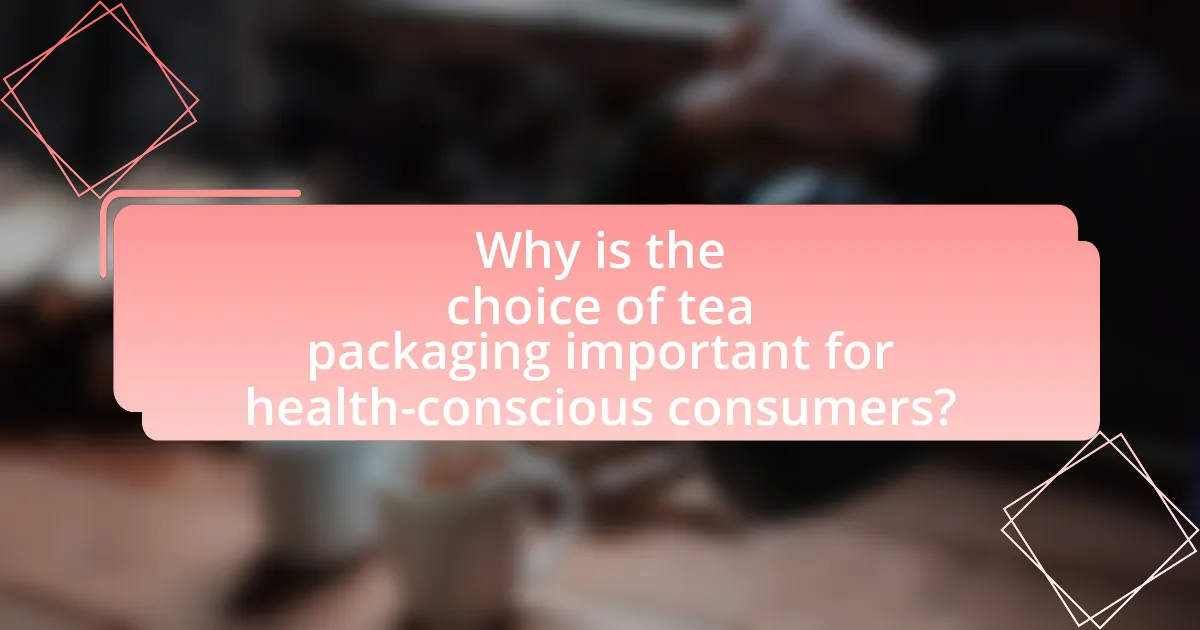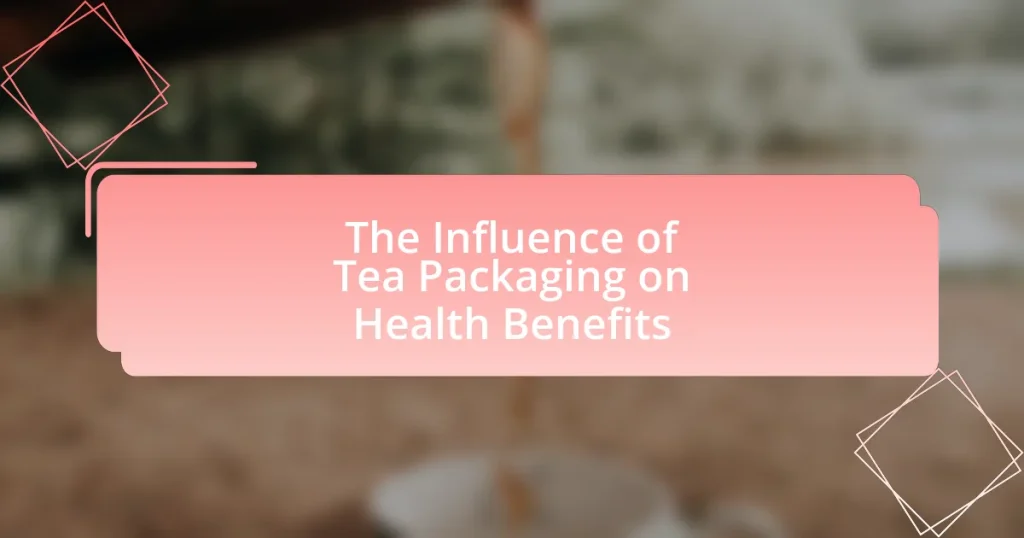The article examines the significant influence of tea packaging on the health benefits associated with tea consumption. It highlights how packaging materials, such as foil and dark glass, preserve bioactive compounds like catechins and flavonoids by protecting them from light, moisture, and air. The discussion includes the impact of different packaging materials on tea quality, the role of packaging design in consumer perception, and best practices for selecting and storing tea to maintain its health benefits. Additionally, it addresses common mistakes consumers make when choosing tea based on packaging and the importance of certifications that ensure product integrity.

What is the Influence of Tea Packaging on Health Benefits?
Tea packaging significantly influences health benefits by affecting the preservation of bioactive compounds. Packaging materials that are airtight and light-resistant, such as foil or dark glass, help maintain the freshness and potency of antioxidants like catechins and flavonoids, which are crucial for health benefits. Research indicates that exposure to light and air can degrade these compounds, reducing their effectiveness. For instance, a study published in the Journal of Agricultural and Food Chemistry found that tea stored in opaque packaging retained higher levels of catechins compared to those in transparent containers. Therefore, the choice of packaging directly impacts the health benefits derived from tea consumption.
How does tea packaging affect the preservation of health benefits?
Tea packaging significantly affects the preservation of health benefits by protecting the tea from light, moisture, and air, which can degrade its quality and efficacy. For instance, opaque, airtight packaging helps maintain the potency of antioxidants and other beneficial compounds in tea, such as catechins and flavonoids, by minimizing exposure to environmental factors that can lead to oxidation. Research indicates that tea stored in vacuum-sealed or foil-lined bags retains its health benefits longer compared to tea in transparent or loosely sealed containers, as demonstrated in studies showing that exposure to light and air can reduce antioxidant levels by up to 50% within weeks. Therefore, effective tea packaging is crucial for maintaining the health benefits associated with tea consumption.
What materials are commonly used in tea packaging?
Common materials used in tea packaging include paper, cardboard, aluminum, and plastic. Paper and cardboard are often utilized for their lightweight and recyclable properties, making them environmentally friendly options. Aluminum is frequently chosen for its ability to protect tea from light, moisture, and air, which helps preserve freshness and flavor. Plastic, while less sustainable, is used for its durability and convenience in packaging. These materials are selected based on their effectiveness in maintaining the quality and health benefits of the tea inside.
How do different packaging materials impact tea quality?
Different packaging materials significantly impact tea quality by influencing factors such as moisture retention, light exposure, and aroma preservation. For instance, materials like foil and vacuum-sealed bags effectively block moisture and light, which helps maintain the freshness and flavor of tea leaves. In contrast, paper or plastic packaging may allow moisture and light to penetrate, leading to degradation in taste and aroma over time. Research indicates that tea stored in airtight, opaque containers retains its essential oils and antioxidants better than those in less protective packaging, thereby preserving its health benefits.
What role does packaging design play in consumer perception of health benefits?
Packaging design significantly influences consumer perception of health benefits by visually communicating product attributes and quality. Effective packaging utilizes colors, imagery, and typography to evoke feelings of healthiness and wellness, which can lead consumers to associate the product with positive health outcomes. For instance, studies have shown that green packaging often conveys natural and organic qualities, enhancing the perception of health benefits. Additionally, clear labeling of ingredients and health claims on packaging can further reinforce consumer beliefs about the product’s health advantages, as consumers tend to trust products that provide transparent information.
How does visual appeal influence consumer choices regarding tea?
Visual appeal significantly influences consumer choices regarding tea by affecting perceptions of quality and desirability. Research indicates that attractive packaging can enhance the perceived value of the product, leading consumers to associate visually appealing tea packaging with higher quality and better taste. A study published in the Journal of Consumer Research found that consumers are more likely to choose products with aesthetically pleasing designs, as these designs evoke positive emotions and create a sense of trust in the brand. This correlation between visual appeal and consumer preference highlights the importance of packaging design in the competitive tea market.
What information is typically included on tea packaging that relates to health benefits?
Tea packaging typically includes information such as the specific health benefits associated with the tea, ingredients, and any relevant certifications. For example, green tea packaging often highlights antioxidants, which are known to reduce the risk of chronic diseases, while herbal teas may specify benefits like improved digestion or relaxation. Additionally, packaging may feature claims supported by research, such as the presence of polyphenols in black tea that can enhance heart health. This information is crucial for consumers seeking to make informed choices based on health benefits.

Why is the choice of tea packaging important for health-conscious consumers?
The choice of tea packaging is crucial for health-conscious consumers because it directly impacts the preservation of tea quality and the prevention of contamination. Packaging materials can affect the tea’s exposure to light, moisture, and air, which can degrade flavor and nutritional content. For instance, studies show that opaque, airtight packaging helps maintain the freshness and antioxidant properties of tea, which are essential for health benefits. Additionally, health-conscious consumers often prefer packaging that is free from harmful chemicals, such as BPA, which can leach into the product. Therefore, selecting appropriate packaging ensures that the tea remains beneficial and safe for consumption.
What health benefits are associated with different types of tea?
Different types of tea offer various health benefits, primarily due to their unique compositions of antioxidants, polyphenols, and other bioactive compounds. Green tea is known for its high levels of catechins, which can enhance metabolism and promote fat oxidation, potentially aiding in weight loss. Black tea contains theaflavins and thearubigins, which may support heart health by improving cholesterol levels and reducing blood pressure. Herbal teas, such as chamomile, are often associated with relaxation and improved sleep quality, while peppermint tea can aid digestion and relieve headaches. Oolong tea has been linked to improved mental alertness and may assist in weight management. These benefits are supported by various studies, including research published in the Journal of Nutrition, which highlights the cardiovascular benefits of black tea, and a study in the American Journal of Clinical Nutrition that discusses the metabolic effects of green tea.
How does packaging affect the bioavailability of tea’s health compounds?
Packaging significantly affects the bioavailability of tea’s health compounds by influencing factors such as light exposure, moisture retention, and oxygen permeability. For instance, opaque and airtight packaging can protect sensitive compounds like catechins and flavonoids from degradation caused by light and oxygen, thereby enhancing their bioavailability. Research indicates that tea stored in vacuum-sealed, dark containers retains higher levels of these beneficial compounds compared to tea stored in clear, non-airtight packaging. This preservation of health compounds directly correlates with improved absorption and efficacy in the human body, as demonstrated in studies examining the stability of polyphenols in different packaging conditions.
What are the implications of packaging on the antioxidant properties of tea?
Packaging significantly affects the antioxidant properties of tea by influencing the preservation of bioactive compounds. For instance, exposure to light, air, and moisture can degrade antioxidants like catechins and flavonoids, which are crucial for tea’s health benefits. Research indicates that opaque packaging can reduce light exposure, thereby maintaining higher levels of these antioxidants compared to transparent packaging. Additionally, vacuum-sealed or nitrogen-flushed packaging minimizes oxygen exposure, further preserving the antioxidant capacity of tea. Studies have shown that tea stored in optimal packaging conditions retains up to 80% of its antioxidant activity over time, compared to only 30% in poorly packaged tea.
How does packaging impact the shelf life of tea and its health benefits?
Packaging significantly impacts the shelf life of tea and its health benefits by protecting the tea from environmental factors such as light, moisture, and air. Proper packaging, such as airtight containers or foil pouches, minimizes oxidation and degradation of essential compounds like polyphenols, which are responsible for many health benefits. Research indicates that tea stored in opaque, airtight packaging retains its flavor and antioxidant properties longer than tea exposed to light and air. For instance, a study published in the Journal of Agricultural and Food Chemistry found that tea stored in vacuum-sealed packaging maintained higher levels of catechins, a type of antioxidant, compared to those stored in conventional packaging. Thus, effective packaging is crucial for preserving both the shelf life and health benefits of tea.
What factors contribute to the degradation of tea health benefits over time?
The degradation of tea health benefits over time is primarily influenced by exposure to light, air, moisture, and temperature fluctuations. These factors lead to the oxidation of polyphenols and other beneficial compounds in tea, diminishing its antioxidant properties. For instance, studies have shown that tea stored in clear packaging is more susceptible to light-induced degradation, resulting in a significant loss of catechins, which are key antioxidants. Additionally, improper sealing can allow air and moisture to enter, accelerating the degradation process. Research indicates that maintaining tea in airtight, opaque containers at stable, cool temperatures can help preserve its health benefits for a longer duration.
How can consumers ensure they are purchasing tea with optimal health benefits?
Consumers can ensure they are purchasing tea with optimal health benefits by selecting high-quality, whole-leaf teas that are minimally processed. Whole-leaf teas retain more antioxidants and beneficial compounds compared to bagged teas, which often contain dust or fannings. Research indicates that green tea, for example, contains catechins, which are linked to various health benefits, including improved heart health and weight management. Additionally, consumers should look for teas that are certified organic, as this reduces exposure to pesticides and chemicals that can diminish health benefits. Checking for third-party testing or certifications can also provide assurance of quality and purity.

What are the best practices for selecting tea based on packaging?
The best practices for selecting tea based on packaging include examining the material, checking for airtight seals, and looking for clear labeling of ingredients and expiration dates. Packaging material, such as foil or dark glass, protects tea from light and moisture, which can degrade quality. Airtight seals prevent oxidation and preserve flavor and aroma. Additionally, clear labeling ensures transparency regarding ingredients and freshness, which is crucial for health benefits. Research indicates that proper packaging can significantly impact the preservation of antioxidants in tea, enhancing its health benefits.
How can consumers identify high-quality tea packaging?
Consumers can identify high-quality tea packaging by examining the materials used, the design, and the labeling. High-quality tea packaging typically employs materials that are airtight and light-resistant, such as foil or glass, which help preserve the tea’s freshness and flavor. Additionally, well-designed packaging often includes clear labeling that provides information on the tea’s origin, ingredients, and brewing instructions, indicating transparency and quality. Research shows that packaging can significantly impact the perception of product quality; for instance, a study published in the Journal of Food Science found that consumers associate premium packaging with higher quality and better taste.
What labels or certifications should consumers look for on tea packaging?
Consumers should look for organic certifications, such as USDA Organic or EU Organic, on tea packaging to ensure the tea is grown without synthetic pesticides or fertilizers. Additionally, Fair Trade certification indicates ethical sourcing practices, ensuring that producers receive fair compensation. Non-GMO Project Verified labels confirm that the tea is free from genetically modified organisms. Lastly, Rainforest Alliance Certified labels signify sustainable farming practices that protect ecosystems and promote biodiversity. These certifications provide assurance of quality and ethical standards in tea production.
How can consumers assess the integrity of tea packaging before purchase?
Consumers can assess the integrity of tea packaging before purchase by examining the packaging for signs of damage, checking for proper seals, and reviewing labeling information. Damaged packaging can indicate compromised product quality, while intact seals ensure that the tea has not been exposed to contaminants. Additionally, consumers should look for certifications or quality indicators on the label, such as organic or fair trade certifications, which can reflect the product’s overall integrity. Research shows that packaging integrity directly affects product freshness and safety, making these assessments crucial for maintaining health benefits associated with tea consumption.
What tips can enhance the health benefits of tea through proper packaging choices?
Proper packaging choices can enhance the health benefits of tea by preserving its freshness, protecting it from light and moisture, and using materials that do not leach harmful substances. For instance, airtight containers made of opaque materials can prevent oxidation and degradation of antioxidants, which are crucial for health benefits. Research indicates that exposure to light and air can significantly reduce the potency of beneficial compounds in tea, such as catechins and flavonoids. Additionally, using food-grade materials that are free from BPA and other harmful chemicals ensures that no toxins contaminate the tea, thereby maintaining its health-promoting properties.
How should tea be stored to maintain its health benefits after opening?
Tea should be stored in an airtight container in a cool, dark place to maintain its health benefits after opening. Exposure to air, light, and moisture can degrade the quality of tea, leading to a loss of antioxidants and flavor. Research indicates that storing tea in a sealed container minimizes oxidation and preserves its beneficial compounds, such as catechins and polyphenols, which are sensitive to environmental factors. Therefore, proper storage is essential for retaining the health benefits associated with tea consumption.
What are common mistakes to avoid when selecting tea based on packaging?
Common mistakes to avoid when selecting tea based on packaging include overlooking the ingredient list, ignoring the packaging date, and failing to consider the type of packaging material. Consumers often neglect to read the ingredient list, which can lead to purchasing teas with additives or artificial flavors that may diminish health benefits. Additionally, many people do not check the packaging date; tea loses flavor and potency over time, so selecting fresher products is crucial for optimal health benefits. Lastly, the type of packaging material matters; for instance, plastic can leach harmful chemicals, while foil or glass preserves the tea’s quality better. These factors collectively influence the overall health benefits derived from the tea.


